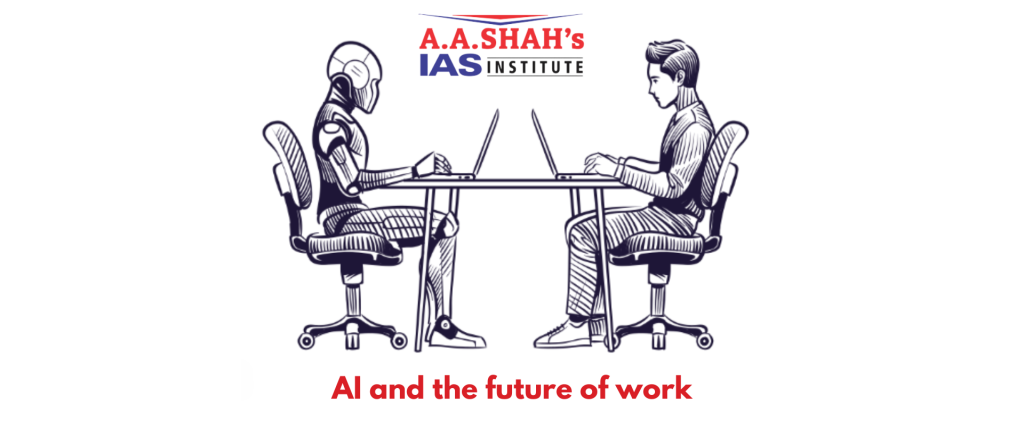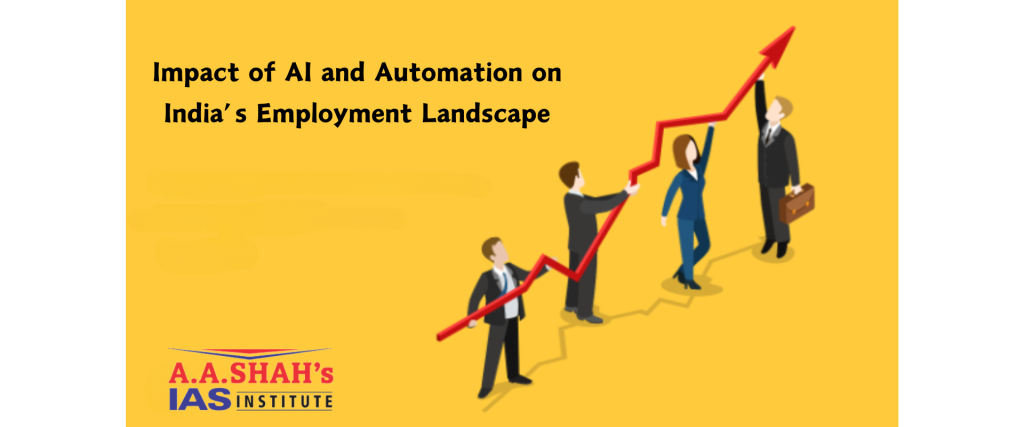
India, with its rapidly expanding population and growing technological landscape, faces the dual challenge of integrating Artificial Intelligence (AI) while managing its impact on employment. As industries increasingly adopt AI technologies, such as machine learning and robotics, to improve efficiency, concerns about job displacement and future employment opportunities have emerged. While AI has the potential to create new roles and redefine existing ones, there is fear that automation could replace human labor in tasks traditionally performed by workers.
An analysis by the International Monetary Fund (IMF) suggests that approximately 40% of global jobs are susceptible to AI disruptions, with developed economies seeing a higher impact. In countries like the US and Europe, around 60% of jobs could be affected by AI, with half of these roles benefiting from AI integration, while the other half may face lower demand, leading to potential job losses or wage reductions. In contrast, emerging markets and low-income countries face lower exposure rates, though they often lack the infrastructure and skilled workforce to fully capitalize on AI’s potential, which could exacerbate global inequality.
This blog delves into how AI and automation are reshaping the job market in India, analyzing their socio-economic effects and proposing strategies to maximize their benefits while addressing their challenges.
Understanding AI and Automation
AI refers to computer systems designed to perform tasks that typically require human intelligence, such as decision-making, problem-solving, learning, and language processing. Automation, on the other hand, uses technology to perform repetitive tasks with minimal human involvement.
AI and automation are already embedded in daily life. Social media platforms, like Facebook and Instagram, use AI to suggest friends based on your activity. Streaming services like Netflix and Prime Video offer personalized recommendations, while search engines like Google predict search queries as you type. In e-commerce, AI helps consumers find products quickly. These technologies streamline experiences, making them more efficient and user-centric.
Together, AI and automation are not just enhancing productivity in industries; they are also enabling machines to perform complex tasks that were once thought to require human intervention.
Understanding AI and Automation
AI refers to computer systems designed to perform tasks that typically require human intelligence, such as decision-making, problem-solving, learning, and language processing. Automation, on the other hand, uses technology to perform repetitive tasks with minimal human involvement.
AI and automation are already embedded in daily life. Social media platforms, like Facebook and Instagram, use AI to suggest friends based on your activity. Streaming services like Netflix and Prime Video offer personalized recommendations, while search engines like Google predict search queries as you type. In e-commerce, AI helps consumers find products quickly. These technologies streamline experiences, making them more efficient and user-centric.
Together, AI and automation are not just enhancing productivity in industries; they are also enabling machines to perform complex tasks that were once thought to require human intervention.
Technologies Driving AI and Automation
Several core technologies are propelling the adoption of AI and automation across various sectors:
- Machine Learning (ML): This subset of AI enables systems to learn from data and improve over time without being explicitly programmed. ML powers applications that evolve as they process new information, allowing businesses to make better decisions based on patterns.
- Robotics: Robotics plays a key role in automation, particularly in industries like manufacturing and logistics, where machines perform physical tasks autonomously or semi-autonomously to improve efficiency and productivity.
- Natural Language Processing (NLP): NLP enables AI systems to understand and process human language, enhancing communication between humans and machines. This technology powers chatbots, virtual assistants, and translation services.
- Robotic Process Automation (RPA): RPA automates repetitive administrative tasks across industries, such as finance and healthcare, freeing human workers to focus on more strategic activities.
Together, these technologies are transforming industries, enhancing productivity, and reshaping the future of work.

AI and Employment: A Global and Indian Perspective
Global Impact
Reports from Goldman Sachs suggest that AI could potentially displace up to 300 million jobs worldwide, with substantial risks in developed economies like the US and Europe. In the UK, a survey revealed that AI could impact up to 8 million jobs, with about 11% of tasks already exposed to automation. White-collar workers in sectors such as customer service, accounting, and sales are particularly vulnerable to job disruption. According to the McKinsey Global Institute, by 2023, up to 14% of employees may need to change careers as AI reshapes job markets globally.
India’s Job Market
India’s IT sector, which has long been a major job provider, faces significant challenges due to the rise of AI. Although the government and industry are focusing on reskilling the workforce to be AI-ready, experts warn of a potential “white-collar recession” in India by 2027. Automation’s reach is not limited to white-collar jobs; about 300 million workers in blue-collar sectors such as manufacturing and healthcare may be affected as well. However, while AI may replace some roles, it is also expected to boost productivity, creating new opportunities within these sectors.
AI Transforming Key Sectors in India
AI is making a significant impact across several industries in India, driving efficiency, improving services, and enhancing customer experiences in various fields.
- Service Sector: The use of AI-powered chatbots, like Amazon India’s Alexa, is revolutionizing customer support, providing instant responses and personalized services. This enhances customer experience while optimizing business operations.
- Healthcare: AI in India is improving diagnostic accuracy, medical imaging, and predictive analytics. AI-driven platforms are also improving healthcare access in rural areas, a critical need in a diverse country like India. For example, the Aarogya Setu app, developed by the Indian government, utilized AI to provide COVID-19 information and contact tracing.
- Finance: The financial sector in India is increasingly adopting AI, with companies like HDFC Bank using AI-driven chatbots for services such as fraud detection, risk assessment, and personalized financial recommendations. AI’s ability to process large data sets in real time enables financial institutions to make faster, more accurate decisions.
Job Creation through AI
As AI technologies continue to evolve, they will create new job opportunities. According to the World Economic Forum, AI could result in a net gain of 12 million jobs globally by 2025. In India, AI and digital interventions are expected to redeploy up to 45 million workers by 2025 through reskilling programs. An estimated 20 million new jobs will be generated in areas such as IT, manufacturing, agriculture, and logistics.
AI is transforming traditional job roles by automating mundane tasks and enabling workers to focus on more complex, creative, and value-added activities. This shift is creating a demand for new skills, especially in data science, machine learning, and AI development.
The Potential Downsides: Job Losses and Displacement
Despite AI’s potential to create new jobs, there are challenges, particularly in sectors that rely on low-skilled labor. India’s manufacturing sector, traditionally labor-intensive, is facing potential job losses due to automation technologies such as AI-driven robotics and 3D printing. The IT and services industries, which have been a cornerstone of India’s economy, are also evolving as automation reduces the need for entry-level roles.
India’s informal workforce, which constitutes around 90% of the labor force, is particularly vulnerable. Many of these workers do not have access to formal training or social security benefits, making it harder for them to transition into new roles. The shift towards automation is also likely to drive greater rural-to-urban migration, putting additional strain on urban infrastructure.
Mitigating Job Displacement
To address the challenges of job displacement, India must invest in comprehensive upskilling and reskilling programs. Initiatives like the Skill India Mission and the Pradhan Mantri Kaushal Vikas Yojana (PMKVY) are already working to equip workers with skills in emerging technologies, including AI, machine learning, and data analytics.
The Digital India Mission is promoting digital literacy and helping workers transition to the digital economy. Additionally, India’s educational policies, like the National Education Policy (NEP) 2020, emphasize the importance of integrating AI into curricula to prepare future generations for the evolving job market.
Fostering Inclusive Growth and Innovation
To support innovation and AI-related start-ups, the Indian government has introduced initiatives like the Atal Innovation Mission (AIM), which supports AI-driven entrepreneurship. Programs such as YUVAi are introducing school students to AI concepts, fostering the next generation of tech talent.
By prioritizing inclusive growth, India can ensure that the benefits of AI reach all sectors, including agriculture and small businesses, which employ a significant portion of the workforce. This will help mitigate the risks of widening inequalities.
Conclusion
AI is transforming India’s job market, creating both opportunities and challenges. By focusing on reskilling the workforce, encouraging innovation, and supporting inclusive growth, India can harness AI’s potential to drive economic growth and job creation. With the right policies and investments in education, AI can help India become a global leader in the digital economy, ensuring that its workforce is equipped for the future.